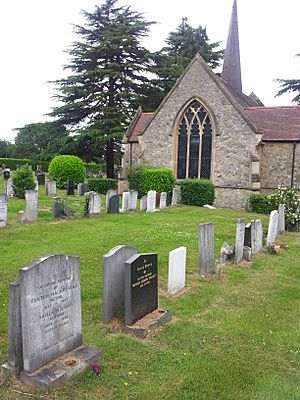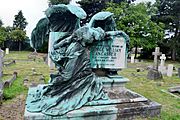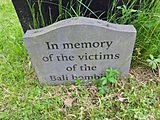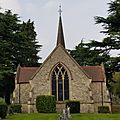East Sheen Cemetery facts for kids

East Sheen Cemetery and chapel
|
|
| Lua error in Module:Location_map at line 420: attempt to index field 'wikibase' (a nil value). | |
| Details | |
|---|---|
| Established | 1906 |
| Location |
East Sheen, London Borough of Richmond upon Thames, TW10 5BJ
|
| Country | England |
| Type | Active |
| Owned by | Richmond upon Thames London Borough Council |
| Size | 16 acres (6.5 hectares) |
| East Sheen Cemetery Chapel | |
|---|---|

Fulton Mackay's grave and the cemetery's chapel
|
|
| History | |
| Founded | 1906 |
| Founder(s) | Barnes Urban District Council |
| Architecture | |
| Architect(s) | Reginald Rowell |
| Style | 14th-century style |
East Sheen Cemetery, originally called Barnes Cemetery, is a special burial ground in East Sheen, London. It opened in 1906 in what used to be a quiet, green area. At first, only half of the land was used for burials. The other half was a plant nursery. In the 1930s, the whole area became a cemetery and was renamed East Sheen Cemetery.
Today, it sits right next to Richmond Cemetery. You can still see the old border between them, marked by a hedge. The chapel at East Sheen Cemetery is used for services for both cemeteries, as Richmond Cemetery's chapel is no longer in use. This chapel was built in 1906 in a style called Gothic revival by a local architect named Reginald Rowell. He was later buried here too! Many important people are buried in this cemetery, and it has some amazing memorials.
Contents
A Look at East Sheen Cemetery's History
This cemetery covers a large area, about 16 acres (6.5 hectares). It first opened as Barnes Cemetery around 1905 or 1906. Before that, it was just woodland. The land in this area was once owned by King George III.
When it first opened, only the northern part was for burials. The southern part was used as a nursery, where plants were grown. In the 1930s, the southern area was also turned into a cemetery, and the whole place became East Sheen Cemetery.
How the Cemetery is Managed
East Sheen Cemetery was first managed by the Municipal Borough of Barnes. The cemetery next door, Richmond Cemetery, was managed by the Municipal Borough of Richmond (Surrey). Since 1965, these two areas joined with another borough to form the London Borough of Richmond upon Thames. Now, the Richmond upon Thames London Borough Council looks after both cemeteries.
The entrance to the cemetery is a bit hidden, set back from the road. It has a tree-lined path and brick gateposts, almost like the entrance to a large country house. During World War II, an air-raid shelter was built near the entrance to protect people. Even though East Sheen and Richmond cemeteries are now connected, you can still clearly see the original border, which is a holly hedge.
The Cemetery Chapel
The cemetery has a chapel that is used for services by both East Sheen and Richmond cemeteries. This is because Richmond Cemetery's own chapel is no longer in use. The chapel is open to people of all faiths and beliefs. It was designed by Reginald Rowell, the local architect who is also buried in the cemetery.
The chapel is a special building, listed as Grade II by Historic England. This means it's an important historical building. It was built in 1906 in a Gothic style from the 13th century, with a tall, thin spire called a flèche.
East Sheen Cemetery is also a protected area. It's known as Metropolitan Open Land and is part of a conservation area, along with Richmond Cemetery and Pesthouse Common. This helps keep it green and special.
Important Memorials to See
East Sheen Cemetery has some very striking memorials. The most famous one is the Lancaster Memorial. It's dedicated to George William Lancaster and his wife Elisa Mary Lancaster, who passed away in the early 1920s. The Lancasters were successful business owners from northern England who made their money in coal mining.
The Lancaster Memorial
Historian Hugh Meller has called the Lancaster Memorial "arguably the most dramatic sculpture in any of London's cemeteries." It truly stands out! This memorial is so important that it was given a Grade II* listed building status in 1992. Historic England says it's "considered one of the most significant 20th-century examples of funerary sculpture."
The memorial features a bronze (metal) sculpture of an angel looking sad over a rectangular stone coffin, called a sarcophagus. The angel and sarcophagus sit on a stone base made of Portland stone. The way the angel's figure flows and its wings droop over the sarcophagus are especially beautiful. The angel was sculpted by Sydney March, who also created the famous National War Memorial of Canada. It's thought that this work was inspired by similar sculptures in Italy.
Other Notable Memorials
Another important memorial, listed as Grade II, is for Markham Buxton (1852–1927). It's a bronze picture carved into a stone slab, called a stele. This memorial was made by Buxton's son, Alfred Buxton, who was also a sculptor. The stone slab is made of granite and has five decorations on top. It also has a message carved into it: "OUR SWEETEST SONGS ARE THOSE WHICH TELL OF SADDEST THOUGHTS". Alfred showed a similar sculpture called "Chanson Triste" at the Royal Academy in 1927, which is probably the same one on his father's grave.
Other interesting memorials in the cemetery include:
- A marble sculpture of a soldier for William Rennie O'Mahony (died 1928).
- A silver-painted wooden dolphin.
- A glass circular disc memorial.
- A sculpture of Jesus as the Good Shepherd with three lambs.
- A mosaic of St Francis and Mary Magdalene on a headstone that is hard to read.
There are also memorials that are not religious, such as:
- A carving of an aircraft on the grave of Royal Air Force Pilot Officer Denis Power (died 1931).
- A sea-themed memorial on the Hervey grave (1917).
- A tiny walled garden remembering Louise Espinosa and her husband Edouard.
The cemetery also has a war memorial for 79 soldiers from the Commonwealth who died in the two world wars. Seventy-one of them have their own headstones: 33 from the First World War and 38 from the Second World War. The Commonwealth War Graves Commission takes care of these graves.
Famous People Buried Here
Many well-known people are buried in East Sheen Cemetery. Here are some of them:
- Clementina Black (1853–1922), a writer, a supporter of women's rights, and a leader in creating trade unions.
- Stephen Andrew Boyd, an editor for The Sunday Times and the person who put together the Sunday Times Rich List.
- Robert Chalmers, 1st Baron Chalmers (1858–1938), a government worker and a scholar of Pali and Buddhism. He later became the Master of Peterhouse, Cambridge.
- William Gilbert Chaloner (1928–2016), a palaeobotanist (someone who studies ancient plants). He was a professor at Royal Holloway, University of London and University College, London.
- Sir O'Moore Creagh, a general and a recipient of the Victoria Cross (a very brave award).
- Sir Miles de Montmorency, a painter and art historian.
- Arthur Donaldson, a fighter pilot.
- Husband and wife Edouard Espinosa (1871–1950) and Eve Louise Kelland (1889–1943), who started the British Ballet Organization, now called bbodance.
- Roy Kinnear, a well-known actor.
- Husband and wife Fulton Mackay (1922–1987), a Scottish actor famous for playing prison officer Mr Mackay in the TV show Porridge, and Sheila Manahan (1924–1988), an Irish actress.
- Sir Alec Martin, a businessman.
- Sir John Martin-Harvey, an actor.
- Sir Ralph Moor, a diplomat.
- Sir Benjamin Morgan, an engineer and economist.
- William Officer, a major general and army doctor.
- Hamilton Reed, a major general and another VC recipient.
- William Ellsworth Robinson (stage name Chung Ling Soo), a famous magician.
- Douglas Scott, a major general and engineer.
- Sir Michael Tighe, a lieutenant-general.
- Ian Walters (1930–2006), a sculptor who created the statue of Prime Minister Harold Wilson in Huddersfield and a large head of Nelson Mandela in London.
- Sir Frederick Wigan, 1st Baronet (1827–1907), a merchant and important local official.
The cemetery also has a grave for some of the victims of the 2002 Bali bombings.
Gallery
-
Grave of actor Roy Kinnear








